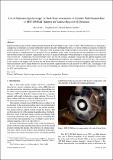| dc.contributor.author | Celik, Murat Alp | |
| dc.contributor.author | Batishchev, Oleg | |
| dc.contributor.author | Martinez-Sanchez, Manuel | |
| dc.date.accessioned | 2010-12-13T16:36:42Z | |
| dc.date.available | 2010-12-13T16:36:42Z | |
| dc.date.issued | 2010-01 | |
| dc.date.submitted | 2010-01 | |
| dc.identifier.issn | 0042-207X | |
| dc.identifier.uri | http://hdl.handle.net/1721.1/60283 | |
| dc.description.abstract | Radiation emission due to Boron atoms sputtered from the Boron-Nitride ceramic walls of a BHT-200 Hall thruster was measured as
a diagnostic for real time assessment of thruster wall erosion and to determine the e ects of various operation conditions on thruster
lifetime. Boron neutral 249.677 and 249.773nm lines were measured using a high resolution spectrometer. Spectral measurement
results and the accompanying analysis and discussion are presented in this study. From the spectral measurements it was observed
that the Boron emission intensity significantly increases for increased discharge voltage pointing to a large increase in the thruster
wall erosion rate. Additionally, the measurements show that for the nominal discharge voltage and the applied magnetic field
intensity, there is an optimum propellant flow rate for minimum Boron emission, thus minimum wall erosion rate. The variation
in the current to the magnet coils showed that the Boron emission intensity increases for increased magnetic field and the Boron
emission intensity shows similar behavior to that of the Xenon single ion emission line intensity at 248.911nm. The findings of the
study show that emission spectroscopy can be used in determining the optimum operational parameters for minimum wall erosion
for SPT type Hall thrusters. | en_US |
| dc.language.iso | en_US | |
| dc.publisher | Elsevier | en_US |
| dc.relation.isversionof | http://dx.doi.org/10.1016/j.vacuum.2010.01.031 | en_US |
| dc.rights | Attribution-Noncommercial-Share Alike 3.0 Unported | en_US |
| dc.rights.uri | http://creativecommons.org/licenses/by-nc-sa/3.0/ | en_US |
| dc.source | Prof. Martinez-Sanchez via Barbara Williams | en_US |
| dc.title | Use of emission spectroscopy for real-time assessment of relative wall erosion rate of BHT-200 hall thruster for various regimes of operation | en_US |
| dc.type | Article | en_US |
| dc.identifier.citation | Celik, Murat, Oleg Batishchev, and Manuel Martinez-Sanchez. “Use of emission spectroscopy for real-time assessment of relative wall erosion rate of BHT-200 hall thruster for various regimes of operation.” Vacuum 84.9 (2010): 1085-1091. | en_US |
| dc.contributor.department | Massachusetts Institute of Technology. Department of Aeronautics and Astronautics | en_US |
| dc.contributor.approver | Martinez-Sanchez, Manuel | |
| dc.contributor.mitauthor | Celik, Murat Alp | |
| dc.contributor.mitauthor | Batishchev, Oleg | |
| dc.contributor.mitauthor | Martinez-Sanchez, Manuel | |
| dc.relation.journal | Vacuum | en_US |
| dc.eprint.version | Author's final manuscript | |
| dc.type.uri | http://purl.org/eprint/type/JournalArticle | en_US |
| eprint.status | http://purl.org/eprint/status/PeerReviewed | en_US |
| dspace.orderedauthors | Celik, Murat; Batishchev, Oleg; Martinez-Sanchez, Manuel | en |
| mit.license | OPEN_ACCESS_POLICY | en_US |
| mit.metadata.status | Complete | |
